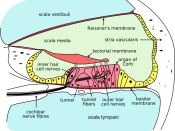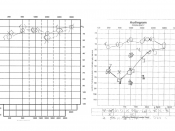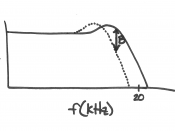The ear is the organ of hearing and balance in vertebrates. The ear converts sound waves in the air, to nerve impulses which are sent to the brain, where the brain interprets them as sounds instead of vibrations. The innermost part of the ear maintains equilibrium or balance. The vestibular apparatus contains semicircular canals which in turn balance you. Any movement by the head, and this apparatus sends a signal to the brain so that your reflex action is to move your foot to balance you.
The ear in humans consist three parts: The outer, the middle, and the inner portions. The outer ear, or pinna, is the structure that we call the ear. It is the skin covered flap of elastic cartilage, that sticks out from the side of the head. It acts like a funnel catching sound and sending it to the middle portion of the ear. The middle portion contains the ear drum and the connection between the pharynx and the drum, the Eustachian tube.
The inner ear contains the sensory receptors for hearing which are enclosed in a fluid filled chamber called the cochlea. The outer and middle ears purposes are only to receive and amplify sound. Those parts ofd the ear are only present in amphibians and mammals, but the inner ear is present in all vertebrates.
The ear can hear in several different ways. They are volume, pitch, and tone. Pitch is related to the frequency of the sound wave. The volume depends on the amplitude or intensity of the sound wave. The greater the frequency, the higher the pitch. Humans can hear about 30 and 20,000 waves or cycles per second. High pitch sounds produce more of a trebly sound, while low pitch sounds produce a rumbling bass sound.
When a person loses...


